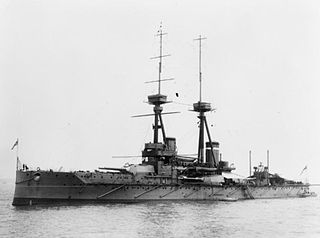Related Research Articles
Seven ships of the Royal Navy have been named Warspite. The origins of the name are unclear, although it is probably from the word spight – an Elizabethan-era spelling variation of both spite and speight – in part embodying contempt for the Navy's enemies, but which was also the common name for the green woodpecker, suggesting the 'Warspight' would poke holes in enemy ships' (wooden) hulls. Until 1919 a woodpecker was used as the ships' crest; the official badge was a cannon, although the woodpecker continued to be used on the ships' tompions or gun muzzle plugs. Warspite carries the most battle honours of any ship in the Royal Navy, with the sixth Warspite being awarded fifteen of them.
Sixteen ships and two shore establishments of the Royal Navy have been named HMS Fox, after the fox.
At least five ships and one shore establishment of the Royal Navy have been named HMS Warrior:
Two ships of the Royal Navy have been named HMS King George V, after George V, King of the United Kingdom, whilst another was planned:

HMS Collingwood was a St Vincent-class dreadnought battleship built for the Royal Navy in the first decade of the 20th century. She spent her whole career assigned to the Home and Grand Fleets and often served as a flagship. Prince Albert spent several years aboard the ship before and during World War I. At the Battle of Jutland in May 1916, Collingwood was in the middle of the battleline and lightly damaged a German battlecruiser. Other than that battle, and the inconclusive action of 19 August, her service during the war generally consisted of routine patrols and training in the North Sea. The ship was deemed obsolete after the war; she was reduced to reserve and used as a training ship before being sold for scrap in 1922.
Eight ships and a shore establishment of the Royal Navy have been named HMS Centurion, after the centurions of ancient Rome. A ninth ship was planned but never built. Ships
Eleven ships of the Royal Navy have borne the name HMS Superb, or HMS Superbe:

Rear Admiral Sir Horace Lambert Alexander Hood, was a Royal Navy admiral of the First World War, whose lengthy and distinguished service saw him engaged in operations around the world, frequently participating in land campaigns as part of a shore brigade. His early death at the Battle of Jutland in the destruction of his flagship HMS Invincible was met with mourning and accolades from across Britain.

Six warships of the Royal Navy have been named HMS Marlborough after the Duke of Marlborough:
Four ships of the Royal Navy have been named HMS Bellerophon after the hero Bellerophon in Greek mythology, whilst another two were planned:

Three ships of the Royal Navy have been named HMS Benbow, after Admiral John Benbow:
Five major warships and one shore establishment of the Royal Navy have been named HMS Thunderer :
Eight ships or submarines of the Royal Navy have been named HMS Anson, after Admiral George Anson:
Several ships of the Royal Navy have been named HMS Howe, after Admiral Richard Howe:
Five ships of the Royal Navy have been named HMS Monarch.
Four ships of the Royal Navy have been named HMS Canada, after the former British colony and modern Dominion of Canada:

Five or six ships of the Royal Navy have been named HMS Cornwallis, after Admiral Sir William Cornwallis.
References
- ↑ "Heritage Structure Section 2 – The Principles and Eligibility Criteria for the Award of Canadian Forces Battle Honours". Government of Canada. 2 December 2021. Retrieved 20 June 2023.
It was the practice in the RCN to award new ships the battle honours won by any predecessor of the same name on a common Commonwealth list for all the Royal navies. While existing ships (and one air squadron) continue to bear such honours by right of continuous service until they are paid off, new construction is awarded only those battle honours won by Canadian ships on a Canadian order of battle